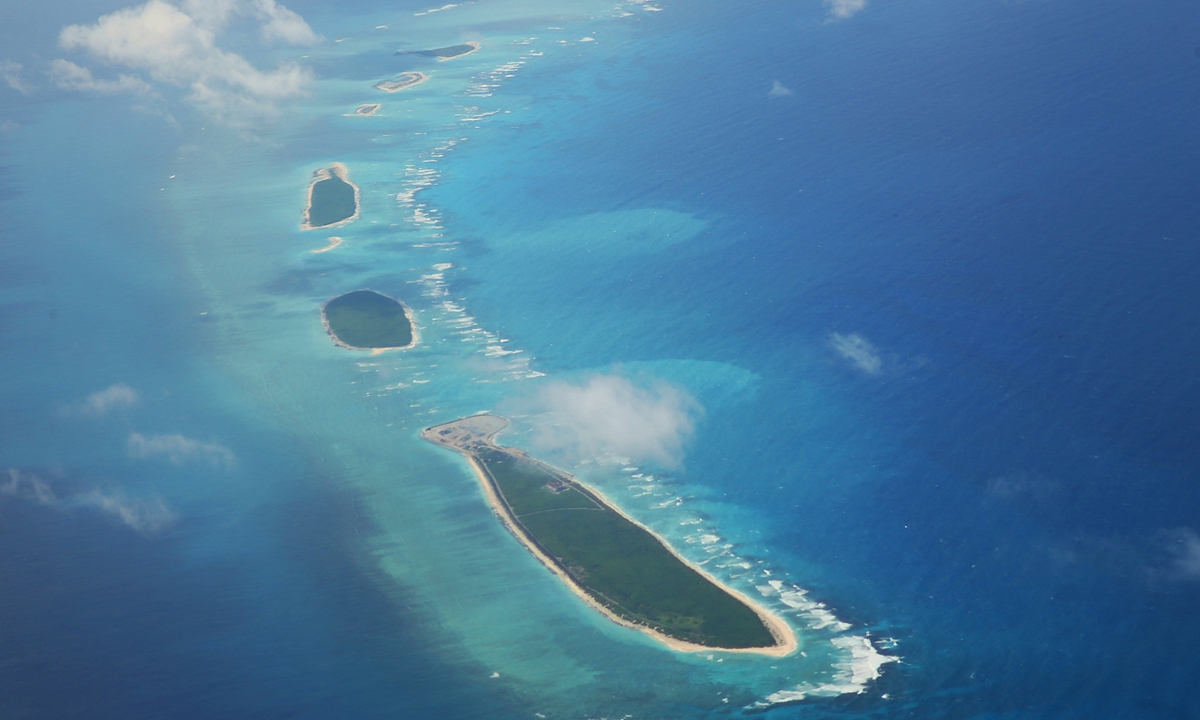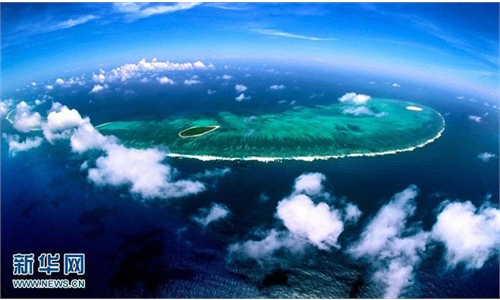Rocks in the Law of the Sea: Some comments on the South China Sea Arbitration Award

South China Sea Photo: VCG
Article 121(2) of the United Nations Convention on the Law of the Sea (the Convention) stipulates that, "The territorial sea, the contiguous zone, the exclusive economic zone and the continental shelf of an island are determined in accordance with the provisions of this Convention applicable to other land territory." According to the International Court of Justice, this rule has the status of customary law, Territorial and Maritime Dispute (Nicaragua v. Colombia), and gives islands major importance in determining maritime spaces.It does however have an exception. According to paragraph 3 of the same article, "[r]ocks which cannot sustain human habitation or economic life of their own shall have no exclusive economic zone or continental shelf." These rocks generate rights only to a territorial sea and a contiguous zone.
This text of critical importance has been widely commented on and was interpreted for the first time in the South China Sea Arbitration award of 12 July 2016 (the Award), which in turn has been the subject of various assessments. Building on this Award, the scope of Article 121(3) needs to be clarified, using the interpretation methods enshrined in the Vienna Convention on the Law of Treaties.
The Award sought first and foremost what should be understood by "rock" for the purposes of the Convention. It noted that the term involved no limitation as to the materials making up the rock, its size, or any other characteristic. As such it gave no specific content to the word "rock" and understood the text as concerning any island, regardless of geology and size.
This interpretation gives rise to a major difficulty: The Convention uses the word "island" in Article 121(1) and (2) and the word "rock" in (3), and on the face of it, it is difficult to see how the same scope can be given to the two words.
The Award assimilated rocks to islands using three arguments. Firstly, it noted that, according to the Oxford English Dictionary (OED), rocks "may consist of aggregates of minerals […] and occasionally also organic matter […]. They vary in hardness, and include soft materials such as clays". This quotation is accurate but incomplete. While the OED does give that as its second definition of "rocks", its first definition is that of a "large rugged mass of hard mineral material." The first definition is equivalent to "roche" in French, the second, to "rocher." But while the English version thus has a degree of ambiguity, the same does not apply to the French version, which refers not to "roches," but to "rochers," meaning, according to the dictionary of the Académie Française, to "craggy masses of hard stone." The Chinese, Russian and Spanish versions similarly correspond to the terminology in French, and it is regrettable, given the ambiguity of the English text, that the tribunal did not look at the other versions. If it had done so, it would have distinguished between "roches" and "rochers" and given the word "rock" its ordinary meaning: that of a rugged mass of hard mineral material.
In order to justify a different interpretation, the tribunal claims the authority of the ICJ which, in the Territorial and Maritime Dispute (Nicaragua v. Colombia), is claimed to have excluded any geological criterion to declare the coral island a rock within the meaning of Article 121(3). This claim is, however, false. In the case mentioned, the Court did have to decide whether Quitasueño was a low-tide elevation or an island. As such, it recalled that an island was a naturally formed area of land, surrounded by water, which is above water at high tide. It then underlined the fact that the definition of "island" contained no geological component. But at no time did it consider the meaning of the word "rock."
In order to justify the solution chosen, the arbitral tribunal observed, lastly, that applying a narrow definition of the word "rock" would give rise to an absurd result. It argued that if such an interpretation were accepted, then certain islands made up of sand, mud, stones or coral would produce vast maritime spaces; whereas the same would not apply to islands made up of hard rock. This would not have been the intention of the authors of the Convention.
The travaux préparatoires of Article 121(3) should therefore be considered, in accordance with Article 32 of the Vienna Convention on the Law of Treaties. Yet these travaux préparatoires do not support the interpretation used in the award.
The text of Article 121(3) stems from three proposals made to the Conference. One of them was from Romania. It initially concerned islets and islands of small size, uninhabited and without economic life. Romania later defined an islet as being less than one square kilometre in area. It specified moreover that small islands which were not or could not be inhabited (permanently) or which did not or could not have their own economic life should be treated as islets. Turkey adopted this approach, but made a distinction between islands without economic life and rocks. The latter were excluded from the scope of Article 121(2). Lastly, 14 African States formulated a proposal which made a particularly clear distinction between islands, islets, rocks and low-tide elevations. They defined a rock as "a naturally formed rocky elevation of ground, surrounded by water, which is above water at high tide."
On the basis of these three proposals, the Chairman of the competent Committee presented the current wording of Article 121(3). One must stress that, unlike certain proposals, the text presented excluded only rocks from the scope of paragraph 2, and not islets. Moreover, certain delegations later sought to expand the scope of paragraph 3, proposing that it should cover islets rather than rocks. Their proposal was rejected. As such, the travaux préparatoires support a literal interpretation of this text which only concerns rocks in the usual meaning of the term.
In any case, even if the word "rock" was not to be given the meaning it naturally has, it would remain that the authors of the Convention only intended to exclude maritime features of small size from the scope of Article 121(2). During the Conference, the classification of the International Geological Institute was mentioned, which defines islands, islets and rocks on the basis of their surface area. No agreement could be reached on the maximum size of islands to be excluded from Article 121(2). But it is clear that it concerned maritime features of small size.
Ultimately, and contrary to the tribunal's award, a rock is, for the purposes of Article 121(3), a rugged mass of hard mineral material of a small size. Rockall is a rock; Tromelin is not. Similarly, as Morocco quite rightly noted in the statement it made when ratifying the Montego Bay Convention, a distinction should be made among the Spanish plazas de soberanía between the islet de Alhucemas, the Rock of Badis and the Chafarinas Islands.
That being said, Article 121(3) of the Convention does not exclude all rocks from the scope of paragraph 2, but only those which are not suitable for human habitation or an economic life of their own. If a rock is uninhabitable and is not suited to such economic life, then it does not generate rights to an EEZ and a continental shelf. But if it fulfills one or the other of these conditions, it does. The tribunal recognized it, but added that features could not develop economic life of their own without the presence of human communities making the island their home. It therefore concluded that the two concepts were necessarily linked - which appears excessive.
It remains to determine what both these conditions mean. Drawing once again on the English version of the Convention alone, the tribunal observed that to generate rights to an EEZ and a continental shelf, an island must be able to "sustain" human habitation or an economic life of its own. The tribunal considered that, because of the use of this verb, an island only generates rights to an EEZ or a continental shelf if it offers conditions enabling human habitation or an economic life to develop on an ongoing basis to a minimal "proper standard".
Continuing its analysis, the tribunal added that "human habitation" should be understood as "settlement" for an indefinite period of time of a human community that could find sustenance and shelter on the island without outside support.
Similarly, to have an "economic life of its own," an island must have the capacity to sustain an economic life independent from the outside. This would not be the case for an island "serving purely as an object for extractive activities, without the involvement of a local population." Lastly, the tribunal added that the status of an island must be determined on the basis of its natural capacity, without taking into account any "substantial human modifications."
This daring conclusion is difficult to reconcile with the French text of the Convention, which refers to rocks which "are not suitable for" human habitation or an economic life of their own. Above all, it is a far cry from Article 121(3) itself, regardless of the language version.
Possibility of human habitation is not the same as allowing the permanent settlement of human communities living without any outside support. Moreover, while a State cannot transform a low-tide elevation or a rock into an island generating rights to a continental shelf or executive economic zone (EEZ), there is nothing to stop it from improving the habitation conditions of a rock. Mont-Saint-Michel and Gibraltar offer good examples of such modifications. The tribunal did not interpret the text; it rewrote it completely.
The authors of the award were perhaps aware of this and sought to justify this rewriting by referring to the purpose of the Convention, as deduced from the travaux préparatoires. As such, they highlighted that Article 121(3) sought to limit the rights derived from islands with a view to protecting the common heritage of mankind and that therefore its scope should be expanded considerably. But this teleological interpretation of the Convention does not correspond to reality.
The travaux préparatoires show that there were two main opposing views at the conference. The first was held by States with island territories, which sought to maintain the traditional rule recognizing the same rights to islands as to continental landmasses. The second was held by States which feared that their maritime spaces would be reduced because of islands belonging to their neighbors, and which moreover belatedly became the defenders of the common heritage of mankind. Article 121 is the result of a compromise between the two positions, as noted in the tribunal's award. It must be interpreted as such. It lays down a principle and attaches to it an indivisible exception. The latter should be interpreted in the light of the declarations made by the various delegations during the conference, without favoring those of certain States as the tribunal did.
Moreover, the tribunal's solution runs counter to the general practice of States, which the award totally ignored. Many countries have, without encountering the slightest protest, established EEZs or claimed the continental shelf around islands which, according to the tribunal, would fall into the category of rocks under Article 121(3). Such countries include Australia, Brazil, Chile, Costa Rica, France, Japan, Kiribati, Mexico, New Zealand, Norway, Portugal, South Africa and the US.
Many bilateral delimitation agreements also recognize such situations. The Commission on the Limits of the Continental Shelf (CLCS) has examined also many cases based on this type of claim, of which only one single case gave rise to an objection. The CLCS has stated that "it had no role on matters relating to the legal interpretation of article 121 of the Convention."
It has however produced recommendations on a great many applications taking into account islands which, according to the award, should not have been taken into consideration. Moreover, many similar applications are ongoing, with no objections raised.
Lastly, the tribunal ignored the jurisprudence of the International Court of Justice. In the 1993 Denmark v. Norway case, the ICJ had to rule on the delimitation of the maritime spaces between Danish Greenland and the Norwegian island of Jan Mayen. Denmark claimed that the island could not sustain human habitation or economic life of its own.
The Court noted that it had no permanently settled population and was inhabited solely by the 25 persons operating weather and radio stations, with supplies brought in from the mainland. It did nonetheless implicitly but necessarily recognize a right to an EEZ and continental shelf to Jan Mayen. In Costa Rica v. Nicaragua, the ICJ had to rule in 2018 on the claim of Nicaragua whereby the Cayos de Perlas generated "maritime projections."
It rejected these claims, as Nicaragua provided "no evidence concerning the capacity of the Cayos de Perlas to 'sustain human habitation or economic life of their own'". By addressing the issue of evidence, it avoided having to interpret Article 121(3).
All in all, the award in the South China Sea Arbitration provided a very fragile interpretation of Article 121(3). This teleological interpretation ignores the ordinary meaning of the words used, the history of the negotiation and the general practice of States. The solution chosen can perhaps be explained by the specific circumstances of the case. It cannot set a precedent.
A rock is a rock: a rugged mass of limited size made up of hard mineral material. Rocks may only generate rights to an EEZ and continental shelf if they can sustain human habitation or economic life of their own. Human habitation involves the possibility for people to live there, but in no way does the text require this habitation to take the form of human communities settled indefinitely and without outside support.
As for "economic life of their own" it does not necessarily have to benefit island communities alone, if any. Lastly, there is nothing preventing States from taking action to improve living conditions and to develop activities on these rocks.
The author is a former president of the International Court of Justice and was a Judge of Court from 1987 and 2005. The article was first published in EJIL: Talk!, the blog of the European Journal of International Law. opinion@globaltimes.com.cn



